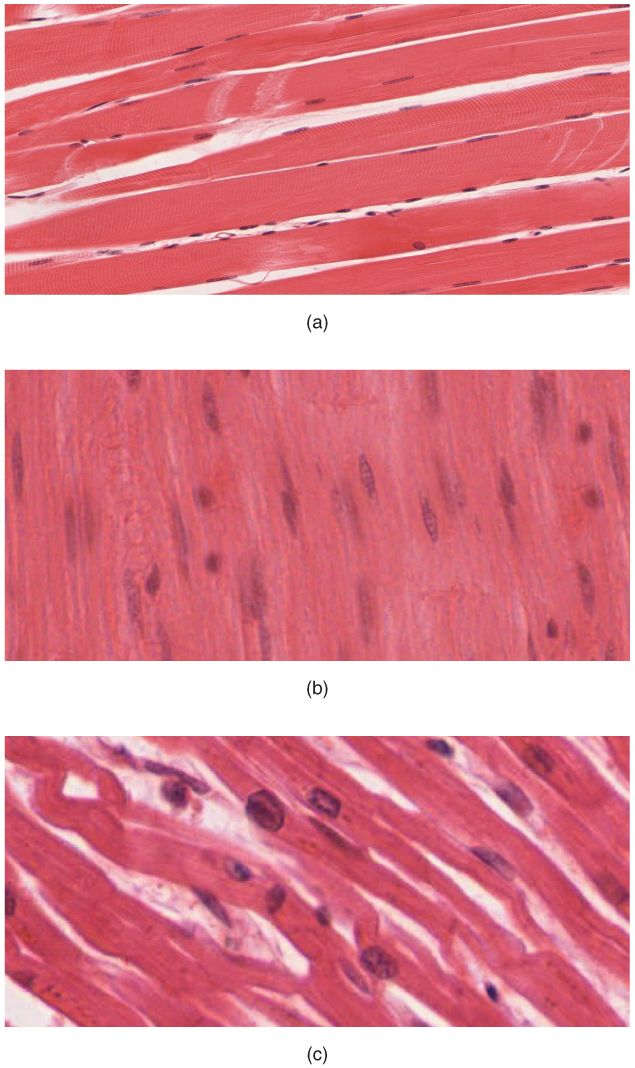64 9.1 Overview of Muscle Tissues
Muscle is one of the four primary tissue types of the body, and the body contains three types of muscle tissue: skeletal muscle, cardiac muscle, and smooth muscle (Figure 1). All three muscle tissues have some properties in common; they all exhibit a quality called excitability as their plasma membranes can change their electrical states (from polarized to depolarized) and send an electrical wave called an action potential along the entire length of the membrane. Skeletal muscle completely depends on signaling from the nervous system to work properly. On the other hand, both cardiac muscle and smooth muscle can respond to other stimuli, such as hormones and local stimuli.

The muscles all begin the actual process of contracting (shortening) when a protein called actin is pulled by a protein called myosin. This occurs in striated muscle (skeletal and cardiac) after specific binding sites on the actin have been exposed in response to the interaction between calcium ions (Ca++) and proteins (troponin and tropomyosin) that “shield” the actin-binding sites. Ca++ also is required for the contraction of smooth muscle, although its role is different: here Ca++ activates enzymes, which in turn activate myosin heads. All muscles require adenosine triphosphate (ATP) to continue the process of contracting, and they all relax when the Ca++ is removed and the actin-binding sites are re-shielded.
A muscle can return to its original length when relaxed due to a quality of muscle tissue called elasticity. It can recoil back to its original length due to elastic fibers. Muscle tissue also has the quality of extensibility; it can stretch or extend. Contractility allows muscle tissue to pull on its attachment points and shorten with force.
Skeletal muscles are made up of contractile proteins—actin and myosin. The actin and myosin proteins are arranged very regularly in the cytoplasm of individual muscle cells (referred to as fibers), which creates a pattern, or stripes, called striations. The striations are visible with a light microscope under high magnification (see Figure 1). Skeletal muscle fibers are multinucleated structures that compose the skeletal muscle.
Review Questions
1. Muscle that has a striped appearance is described as being ________.
- elastic
- nonstriated
- excitable
- striated
2. Which element is important in directly triggering contraction?
- sodium (Na+)
- calcium (Ca++)
- potassium (K+)
- chloride (Cl–)
3. Which of the following properties is not common to all three muscle tissues?
- excitability
- the need for ATP
- at rest, uses shielding proteins to cover actin-binding sites
- elasticity
Critical Thinking Questions
1. Why is elasticity an important quality of muscle tissue?
Glossary
- cardiac muscle
- striated muscle found in the heart; joined to one another at intercalated discs and under the regulation of pacemaker cells, which contract as one unit to pump blood through the circulatory system. Cardiac muscle is under involuntary control.
- contractility
- ability to shorten (contract) forcibly
- elasticity
- ability to stretch and rebound
- excitability
- ability to undergo neural stimulation
- extensibility
- ability to lengthen (extend)
- skeletal muscle
- striated, multinucleated muscle that requires signaling from the nervous system to trigger contraction; most skeletal muscles are referred to as voluntary muscles that move bones and produce movement
- smooth muscle
- nonstriated, mononucleated muscle in the skin that is associated with hair follicles; assists in moving materials in the walls of internal organs, blood vessels, and internal passageways
Solutions
Answers for Review Questions
- D
- B
- C
Answers for Critical Thinking Questions
- It allows muscle to return to its original length during relaxation after contraction.

